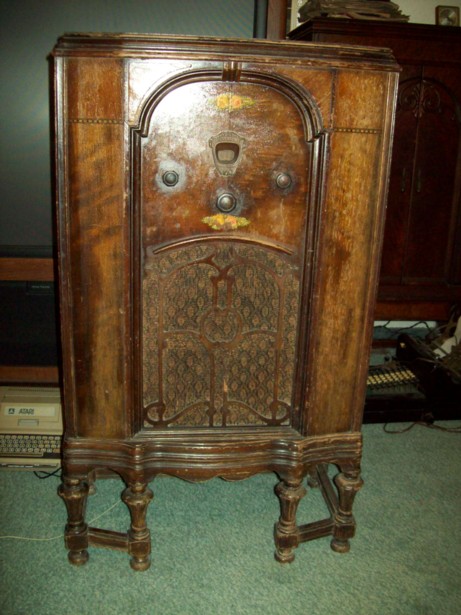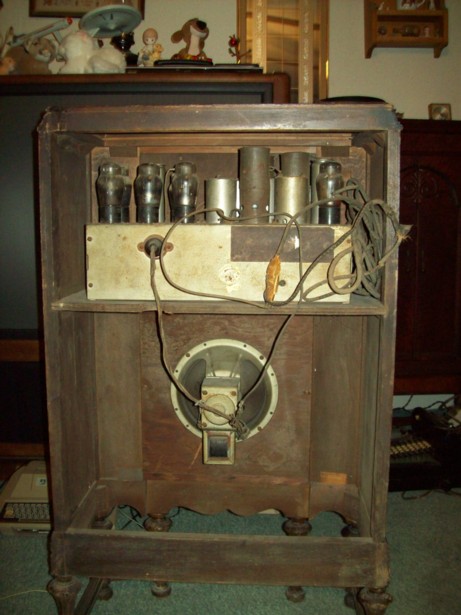Posts: 2,005
Threads: 361
Joined: Jun 2010
City: Dover, OH
I had a moment of weakness today while checking out a recently opened antique shop and bought a six-legged Silvertone console radio. Being that Silvertones are hard to find around here and that any before 1935-36 are impossible to find with the legs intact, I bit. I tried every excuse I could not to buy it because I am short on cash and the one ton truck is a flatbed. Well, it actually fit inside the cab!
Anyways, I have no idea what model this unit is and need to find out. The tag has become so brown that I can just barely make out the tube diagram, with everything else lost to time but the serial number. It's not a big console, but it has a deep 10 tube chassis crammed in there with an odd tube layout. For one thing, it uses an 83 rectifier that is still alive, with the other oddity being that it uses four type 45 tubes! Checked the tag and that is correct an most of the tubes are still the original Silvertone brand. Anyways, pictures should help. Missing a small piece of the grill, but I am using this radio to get my foot in the door. Guy supposedly has several others in better shape that he is going to cycle through the shop.


No matter where you go, there you are.
Posts: 204
Threads: 6
Joined: Jun 2006
City: Moundsville
State, Province, Country: WV
Jayce,
Not too many options for a 10 tube set with 4-45's and an 83:
http://www.grillecloth.com/sylvania/tube...ubmit&db=5
Carl
Northern Panhandle, WV
Posts: 2,353
Threads: 92
Joined: May 2010
City: Clayton, NC
Hello, Jay: I believe what you have is a model 1720 "Challenger." They were advertised as a 10 tube set at a 7 tube price.
The tube lineup for a 1720 is four-45s, one-6A7, one-37, one-75, two-78s, one-5Z3.
These sets have an "extended" broadcast band that goes (I think) to 1800KHz.
Posts: 94
Threads: 3
Joined: May 2010
City: Albuquerque, NM
(04-21-2012, 07:11 PM)TA Forbes Wrote: Hello, Jay: I believe what you have is a model 1720 "Challenger." They were advertised as a 10 tube set at a 7 tube price.
The tube lineup for a 1720 is four-45s, one-6A7, one-37, one-75, two-78s, one-5Z3.
These sets have an "extended" broadcast band that goes (I think) to 1800KHz.
Hi,
The model 1720 is viewable at the Radio Museum site, shows a different dial scale setup, but other than that is real close. The 1725 uses a different cabinet so that's not it. The model 7065 uses the exact same chassis but cannot locate a pic of the cabinet so maybe it is still a possibility? All three models made in '33-34'. John
Posts: 4,612
Threads: 51
Joined: Sep 2008
City: Sandwick, BC, CA
Silvertone, or probably Colonial radio under contract, must have used the type #45s as a cost saving measure and as a bit of "Tube Stuffing" since they were more or less obsolete tubes by 1932. A type 83 sounds strange as it's a mercury vapor rectifier, are you sure it isn't an 83V? A 5Z3 sounds more typical for the power requirements, though maybe they used an 83V on a different production run?
Regards
Arran
Posts: 2,353
Threads: 92
Joined: May 2010
City: Clayton, NC
Or possibly the 83 was used as a replacement? The pins and filament V are the same. Check the tube socket and see if there is embossing there listing what tube should go there. Silvertone used the 83 tube in some of their high-tube count sets like the 1641, 1722, 1726, and 1732.
Silvertone made many off-variants of the same set. I am willing to bet that besides the escutchion difference, that they are the same set.
Also, note that everything else, including the grillework, is the same as the example in the Radio Museum.
Posts: 2,128
Threads: 18
Joined: Oct 2008
City: Merrick, Long Island, NY
(04-22-2012, 09:13 AM)TA Forbes Wrote: Or possibly the 83 was used as a replacement? The pins and filament V are the same. Check the tube socket and see if there is embossing there listing what tube should go there. Silvertone used the 83 tube in some of their high-tube count sets like the 1641, 1722, 1726, and 1732.
Silvertone made many off-variants of the same set. I am willing to bet that besides the escutchion difference, that they are the same set.
Also, note that everything else, including the grillework, is the same as the example in the Radio Museum.
Nothing wrong using an 83 instead of 83V, but the 83, if that's what it is, is getting harder to find and is used in Hickok Tube testers. The radio didn't need to have this type of tube.
Don't plug it in until you go through the usual drill of replacing the electrolytics and paper caps, testing the power transformer with tubes out, and replacing rotted wiring. Stick with us, and you'll have a great performer in a month or two.
Posts: 2,005
Threads: 361
Joined: Jun 2010
City: Dover, OH
The tube diagram on the back calls for an 83, or at least as much as I can make out of the number it does. The guy had this thing plugged in and it popped on while I was looking at it, couldn't turn it back off so I yanked the plug to avoid further damage. One thing I was able to tell is all the tubes were lighting, no fireworks, and I had audio. My lightbulb board indicated a short in the. cord, so I'm not messin' with it until I get the money and time to do things right. Thanks for the help and info so far. 
No matter where you go, there you are.
Posts: 2,353
Threads: 92
Joined: May 2010
City: Clayton, NC
Keep us posted on how it turns out, Jay. It should be a nice player when you get it done.
Users browsing this thread: 1 Guest(s)
|





